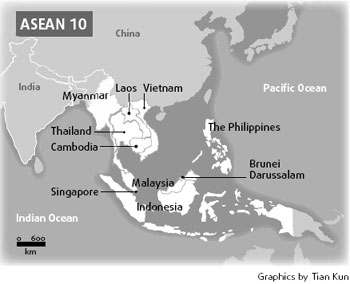Trade rising, but hurdles remain
Updated: 2007-08-08 14:01
The volume of trade between China and ASEAN has been increasing faster than expected, driven by the implementation of free trade agreements, but hurdles remain on the horizon.
"This year, the annual bi-lateral trade is expected to reach $190 billion, and next year, it will definitely surpass $200 billion," predicted Xu Ningning, deputy secretary-general of the China-ASEAN Business Council.
The target of China-ASEAN trade surpassing $200 billion by 2010 is likely to be realized two years earlier than expected.

Since the establishment of the China-ASEAN free trade area in November 2002, China and ASEAN have signed agreements on liberalizing the commodity trade in 2004, and the service trade in early 2007.
The agreements have helped bilateral trade continue its rapid climb. In 2005, it surpassed $100 billion for the first time, reaching $130.3 billion, and the figure rose by 23.4 percent in 2006, reaching $160.8 billion.
The setting up of the free trade framework is now in the final phase, with the two sides currently working on agreements on mutual investment.
In 2010, the China-ASEAN Free Trade Area is expected to come into being, becoming the third largest free trade area in the world in terms of gross domestic product, next to the European Union and the Free Trade Area of the Americas.
China was the first Asian nation to embark on free trade negotiations with ASEAN, stimulating talks between ASEAN and Japan, South Korea and India, and quickening the journey towards a unification of the East Asian economy.
ASEAN first mooted the unification of East Asia's economy in 1998 after the region was hit by financial crisis. The association proposed quickening recovery by closer cooperation between neighboring nations.
"The China-ASEAN Free Trade Area is developing much faster and than Asia's other free trade areas," said Zhai Kun, an expert on Southeast Asia.
But the other side of the coin is the remaining issues that threaten economic relations.
|
|

